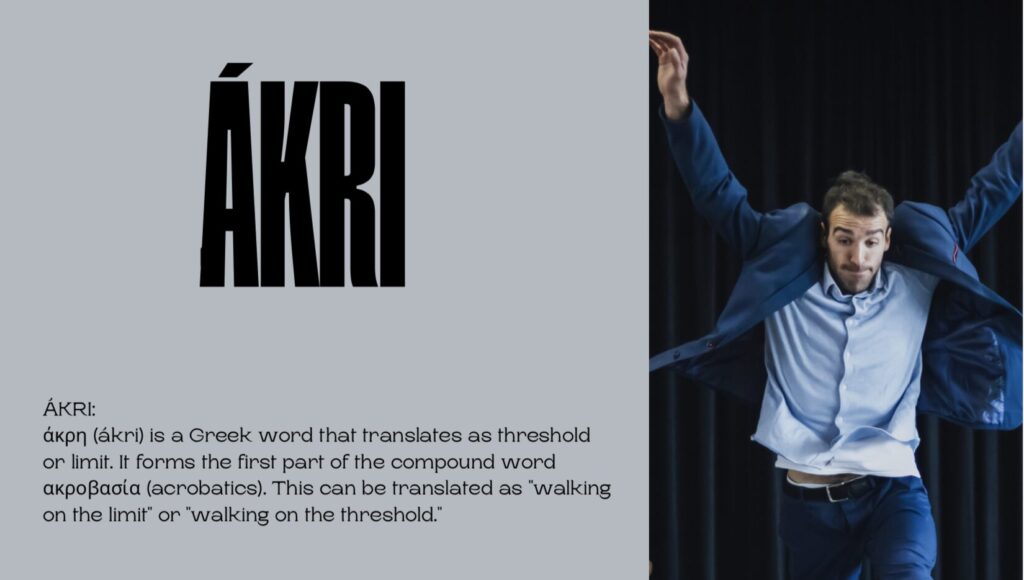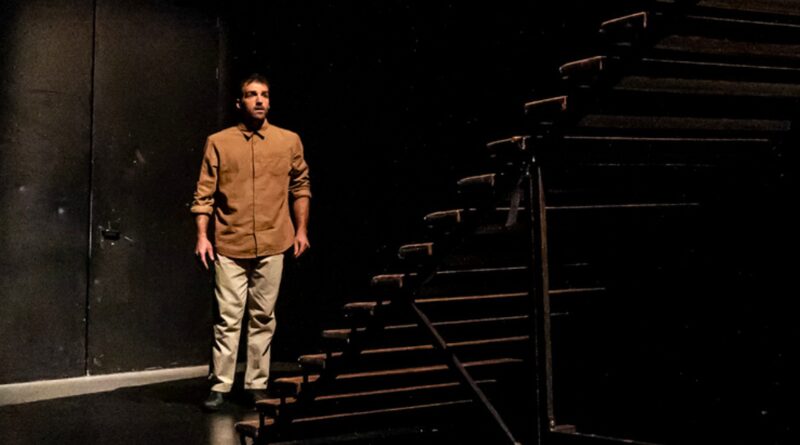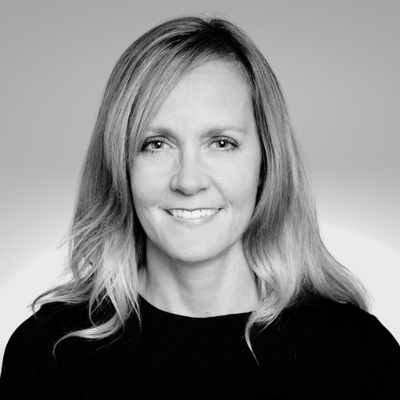Creating Circus Work – From Inspiration To Stage: The Showcase
In this trilogy of circus artist interviews, we delve into the personal journeys of three solo artists whose work, in varying stages of development, was recently presented at UP Festival in Brussels.
In the second stage of the creation process is the Showcase.
As a part of this year’s Focus Catalan Arts, Manel Rosés performed a 30-minute excerpt of his solo work,Akri. Showcasing artists have the opportunity to impress and influence international circus and performing arts professionals both by performing live and by actively networking during the festival’s social gatherings. And as Rosés explains, every performance brings new learnings, evolving a work from its in-studio form to an audience-tested, stage-ready show.
Akri is a Greek word that translates as “threshold” or “limit.” It forms the first part of the compound word “ἀκροβαοία” (acrobat), meaning “walking on the edge” or “walking on the threshold.” Akri is a circus show performed by one acrobat and a staircase that explores the concept of “threshold.” The staircase, which is both a circus apparatus and a set design, represents a passage between two spaces while symbolizing a profession and a way of life.
Stacy Clark (SC): How and when did you get started in circus arts, and who were your teachers, mentors, and role models?
Manel Rosés (MR): My father was part of the team in one of the first non-traditional circus groups / companies in Catalunya, Circ Cric. At its beginning this group was mostly amateur. Slowly it got more and more professional, but when this professionalization started to happen, my father had already left the group to work in another field. However, he kept in contact with this company.
With that I want to say that since I was a kid, I had a bit of connection with circus since we regularly went to see their performances.
On the other hand, my mother has always nourished me with all sorts of different arts. Giving me books to read and bringing me to watch movies or shows.
My first contact with the circus arts was through a friend who showed me how to juggle at the age of 15. After that, we did a juggling course together at the Barcelona Circus School. And from there I got “trapped” in circus. When I finished high school, I started the circus training at the Barcelona Circus School for two years, during which I discovered many different circus disciplines. Right after that, I went to DOCH in Stockholm for three more years. There I specialized in handstand and teeterboard.
The school teachers that have had an impact on me include Albaerto Felicitate, Sonia Dominguez and Janne Rosen in the acrobatic disciplines; Alexander Gavrilov (Sasha) and Vicente for handstands; and Ricardo Gallardo for theater.
I would say my artistic development started to happen more seriously after DOCH, when I started working in different circus constellations and facing creative challenges and questions. During this time I also attended other courses in different fields such as dramaturgy, clown, dance, and circus research.
Other than schooling, being part of the creation and the tour ofIntarsi from Circo EIA, creating our own showGregarious with my colleague Nilas Kronlid, and working with directors such as Roberto Magro and Joan Català has had the biggest impact on my artistic development.
SC: What was the genesis of your show concept? Did the title (the Greek word Akri, and its meaning) inform the development of your idea, or did you find the title later on?
MR: The title came later on, in the middle of the process. So while the process didn’t start from the title, the title and the concept influenced part of the process.
I started playing with different ideas in a studio because I felt the need to investigate and play alone. But I didn’t have a clear concept or idea when I started. I brought the stairs with which I had done an act before to see if I could find other meanings and possibilities with them. That started opening doors for possible concepts and ideas.
At that time my mother gave me a book to read:Novecento from Italian writer Alessandro Baricco. I connected very strongly with the story and the main character, Novecento—a person who never leaves the ship in which he was found as a newborn. To me the essential question of the story is: why does Novecento never leave the boat? Is it fear? Or is it wisdom?
I connected with this story because as an acrobat, I have sometimes had the drive to change my life and stop doing acrobatics and circus, but somehow I always stay. That made me reflect about what I do, which is mostly acrobatics, and I found that in the etymological definition of the word “acrobat,” there is the concept of the “edge” or “threshold.” I found that “edge” interesting to express the drive to change one’s life and never doing it, but often being on the edge of doing it.

SC: Describe the evolution of this work: for example, your acrobatic research, dramaturgical process, and collaborations with stage designers and technicians.
MR: The image that best describes this process is the image of a volcano mountain that rises up by destroying the mountain itself, one eruption after the other. I have created and destroyed material during the whole process but somehow, some things remained.
This way of creating is exhausting and takes a long time.
The acrobatic research has had two main lines: the acrodance handstand work and the slapstick work. The acrodance handstand work has been the “easiest” part, since it is the thing I am more used to. The slapstick has been a bit harder, but very interesting. Somehow slapstick is very close to acrobatics but at the same time, in order to make it credible, you need to put your body in a place that is almost at the loss of control, but not completely. And that is quite contrary to the acrobatic work, in which you want to be in control all the time.
The dramaturgical process has been, and still is the hardest. In the beginning of the process I had the will to try to make a narrative show because I thought that the spectator connects better through a story, and I wanted to prove that it is possible to explain a story through circus. I failed. I tried different options, but none of them were convincing, and felt like an intruder in a world that I don’t control. I realized I had to focus on the physical research and the object research first. From there things started to happen in a more natural way, and although the Novecento reference started to fade, it never completely disappeared, and I still come back to the Novecento story when I am lost.
I have brought many people to collaborate in the process. Two of them, Roberto Magro and Joan Català, have been following me all along and have helped me a lot to either inspire the work, clean up some of the material, or make me aware of what is perceived from outside. But other people have come in different moments for concrete things or special moments of the process. For example, Guga Arruda helped me with the slapstick and Stephano d’Argenio helped me in the very beginning with the ideas and analyzing Novecento. Diego Rada, a friend and sound/light technician, has been helping and working with me from the beginning and that has been really helpful. He has not only been a technician but has also proposed some ideas that are in the show.
SC: Tell us about your process of conceiving, designing, and then building your staircase (ladder) – described as being both an apparatus and a set design.
MR: The apparatus side of the stairs has been both simple and complicated. I had already done an act with a handstand stair in the past, so I knew how to make a stair in order to make it good for acrobatics and handstands. However when the slapstick work started to appear, I realized I had to make a bigger staircase to make falling from the stairs more spectacular and interesting. The biggest challenge was to find a way to make the stair slippery enough to be realistic. After many trials I found out the right combination of materials on the stair and on the shoe.
The “scenographic” side of the stair has been quite natural. At first I thought I had to cover one side of the stair with wood to make it more look like a house or an indoor space. But when we started combining the stairs with the door and started playing with lights, we realized it was not necessary because the staircase itself was enough.
SC: What is your greatest challenge in creating a one-person show?
MR: I think the greatest challenge is to be strong in one’s decisions and ideas. It is very easy for feedback to make you doubt things that you should not doubt, because there is no one else to evaluate the feedback with. It is also very easy to discard material when there is no one else to fight for the material that has been created. So it is the biggest challenge, but also the biggest lesson.
SC: What learnings and benefits do you gain from presenting your work in the UP Festival showcase?
MR: I gain the benefit of being visible in a festival with a lot of professionals from all over Europe and even the world. And particularly, after playing at the showcase, I got the feeling that the proximity of the audience is quite important in this show. The fact the audience is level with the stage helps the connection with the spectator.
...Do you have a story to share? Submit your news story, article or press release.





